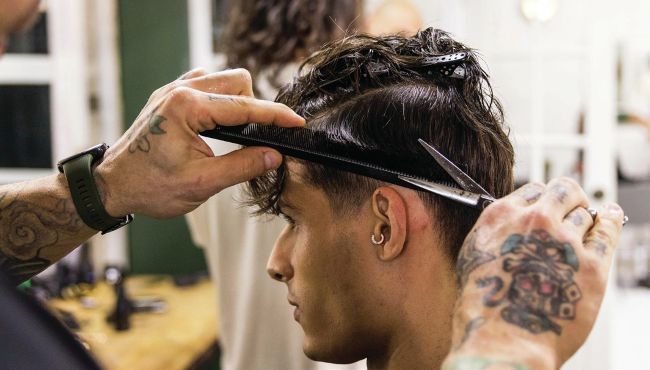SPONSORED FEATURE
TAPER VS FADE
ASK THE EXPERTS
PETE CRANFIELD BREAKS DOWN THE DIFFERENCE BETWEEN A TAPER AND A FADE
TECHNIQUE
“I often get asked by barbers on social media what the difference is between a taper and a fade so I wanted to demonstrate this on the same model, starting with a taper cut and moving into the fade to point out the key differences side-by-side.”
I started by giving Jhonatan a low taper to show the contrast in length on top and to demonstrate how the taper provides more scalp coverage through the back and sides of the head compared to a fade. A low taper involves gradually reducing the hairlength from the top down to the nape of the neck and the sideburns, resulting in a subtle blend that maintains more hair around the ears and lower portions of the head. This technique is ideal for clients who prefer a softer, less dramatic transition between the longer hair on top and the shorter hair on the sides and back.

After completing the taper, I moved on to the fade. A fade typically exposes more of the scalp, creating a striking contrast between the longer hair on top and the much shorter hair on the sides and back. For the fade, I began by establishing a skin line around the midpoint of Jhonatan’s head, using my clippers to create a clean and defined line. Using a No.1 guard, I created a barrier between the skin line and the longer hair above it, blending the two sections smoothly. Gradually decreasing the guard size, I blended the skin line into the surrounding hair, ensuring a smooth transition free of visible lines.
PRODUCTS
I USED THE NEW BABYLISSPRO GOLD LO-PRO FX CLIPPER AND SKELETON TRIMMER TO CREATE THE TAPER AND FADE, AND THE NEW BABYLISSPRO FALCO DRYER TO STYLE THE HAIR INTO THE FINISHED LOOKS.
TIPS
• The taper lever on the Lo-Pro FX Clipper has notches that allow you to control tapers and fades easily. These notches enable you to create a more accurate and perfected fade and taper.
• Consultation is very important. Some clients don’t realise how short a fade or skin fade is, while others will ask for a fade when they ideally want a taper, which is less harsh. Always make sure your client understands what the final look will be like.
• Well-maintained and oiled blades are needed to create both of these looks. They can take time, and your blades need to be well-lubricated to handle the long task of creating such a detailed look.